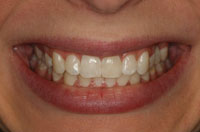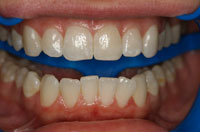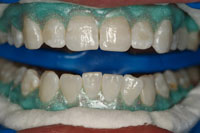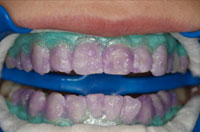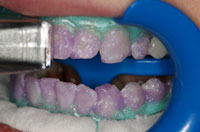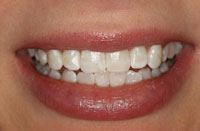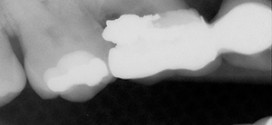In my private practice in the greater Detroit area, I have offered in-office whitening for my patients for many years. Patients feel great about themselves when they see the results, and it’s also a consistent source of additional revenue for the practice.
But many practices still do not provide in-office whitening for various reasons. Some doctors think that in-office whitening takes too long, and thus wastes valuable chair time. Others may be afraid that they’ll cause patient sensitivity or they don’t think that they can sell the service to patients.
A new laser whitening system (ezlase Whitening and Pain Relief System [BIOLASE Technology]) solves all of that. In the last year, I have used the ezlase laser (BIOLASE Technology) with their special whitening handpiece and proprietary LaserWhite20 gel to provide excellent results for more than 200 patients. Since each case took less than 20 minutes of procedure time (plus patient prep and post-op), it’s easy to schedule several whitening cases per day.
|
Lasers Versus Simple Light
First, it’s very important to understand that not all in-office whitening systems actually utilize a laser. Although many systems utilize light, they do not use laser light. Laser energy is absorbed by special particles in the whitening gel to activate the hydrogen peroxide, which accelerates the whitening process faster than “simple” light does, so the procedure time is dramatically shorter. In a typical day, I can schedule almost twice as many in-office whitening cases with a laser compared to other whitening systems.
The US Food and Drug Administration first gave clearance for an in-office laser whitening system almost 10 years ago. Today’s products not only perform faster, but they are also very easy to learn and integrate into your practice. In addition, the same dental laser used for whitening can also be used for everyday soft-tissue and hygiene procedures, such as gingivectomies, troughing for crown and bridge impressions, and sulcular debridement. It can even be used to temporarily relieve minor pain, such as pain caused by temporomandibular joint disorder. On the other hand, other light-based whitening systems can’t offer anything more. The multiprocedure capabilities of lasers help your practice realize an even greater return on investment.
Easy Technique
The protocol for the ezlase whitening system is very easy, and no special training is required. The first step is to prep the patient. After a thorough examination, remove plaque and superficial stains, and then measure and record the initial shade of the patient’s teeth. Apply petroleum jelly to the lips, insert cheek retractors, then apply and cure liquid dam (included in BIOLASE’s whitening gel kit) onto the gingiva.
The next step is to mix the whitening base gel and activator gel together. The base and activator gels are shipped in separate syringes, so connect the syringes together, and then push each plunger back and forth for about 30 to 45 seconds. The resulting mixture is a gel with 38% hydrogen peroxide concentration. The mixed gel does not have a long shelf life, so you should only mix right before applying it to a patient’s teeth.
Connect a brushed applicator tip to the syringe of mixed gel, and apply a thin, uniform layer to teeth 4 to 13 and 20 to 29. Make sure that the gel does not contact the patient’s gingival, tongue, or lip, and that it is not swallowed.
Before activating the laser, ensure that everyone in the operatory wears the appropriate laser safety glasses (included with the ezlase laser). Place a disposable clear protective cap over the laser handpiece, and connect the handpiece to the laser delivery system. Set the ezlase laser to 7 W power, continuous wave mode, and 200 Joules energy output (all explained in the included, easy to follow instructions for use).
The handpiece is designed to treat a full quadrant of 4 to 5 teeth at a time. So place the handpiece about 1 mm away from a quadrant, and then activate the laser for 30 seconds to allow 200 J of laser energy to be applied. Continue this step for the remaining quadrants, and then repeat the process for all quadrants one more time. Dividing the teeth into quadrants allows the laser to accelerate the whitening process while minimizing heat induced to the teeth. Leave the gel on the teeth for an additional 5 minutes to allow the teeth to absorb the laser-activated hydrogen peroxide, allowing continued whitening after the laser exposures.
Remove the gel with high-speed suction, and then flush with an air and water spray to remove any residual gel. Apply a second coat of mixed gel using a new brushed applicator tip, and repeat the laser process described above.
That’s it! Less than 20 minutes of gel to tooth contact time and laser application.
To finish up, thoroughly rinse with water, and carefully remove the liquid dam. Apply moist cotton gauze over the gums and teeth and wait for a few minutes to rehydrate enamel and tissue. If desired, a final polish can be performed with a fine grade paste to give luster and shine to the teeth.
Finally, measure the new shades, compare it to the original, and discuss the outcomes with your patient.
Great Results
The results are immediate. Patients who’ve never had in-office whitening before can’t believe how good their new smile looks before even getting out of the dental chair. At this point, it is critical to advise them not to consume products that stain teeth for up to the next 48 hours, such as coffee, red wine, tobacco, tea, some fruits, tomato sauce, etc. If followed, the results will continue to get even better during this time.
An ADA Professional Product Review from Spring 2008 (Vol. 3, Issue 2) and a study published in the Journal of Cosmetic Dentistry in Summer 2003 (Volume 19, Number 2), both concluded that laser whitening systems provided approximately 9 shades of improvement, compared to approximately 8 shades of improvement on non-laser systems (using the VITA Shade Guide Brightness Scale).(1)
In my practice, I can typically achieve six shades of improvement, and sometimes the improvement is as good as nine shades.
But even with so many great outcomes, it is very important to discuss potential results with patients before the procedure begins. The degree of whitening varies from patient to patient based on type of stain, enamel thickness, tooth structure, and age. So patients deserve to have realistic expectations before the treatment begins.
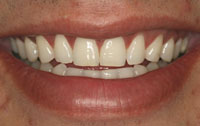 |
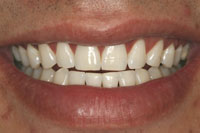 |
| Figure 7 and 8. Pre- and post-op teeth whitening case 2. |
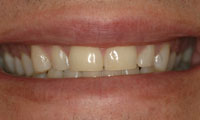 |
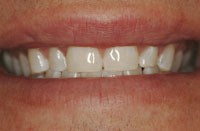 |
| Figures 9 and 10. Pre- and post-op teeth whitening case 3. |
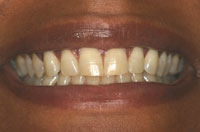 |
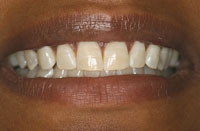 |
| Figures 11 and 12. Pre- and post-op teeth whitening case 4. |
Reduced Sensitivity
A concern that some doctors have had with in-office whitening is patient sensitivity. But with laser whitening, my patients have experienced little to no sensitivity.
Because of the unique properties of the laser, the gel-to-tooth contact time is about half as long as other in-office whitening systems that use a similar concentration of hydrogen peroxide gel. Less contact time results in less sensitivity.
When the laser shines on the teeth, patients experience a warm sensation, but it is not painful or discomforting. The laser shines on the teeth for only short, 30-second intervals, compared to other light-based in-office whitening systems that shine a heat-producing lamp for several minutes at a time.
The BIOLASE whitening gel kit also includes a syringe of desensitizing gel with potassium nitrate that can be applied after the procedure to further minimize sensitivity. Also, as a precautionary measure, doctors may recommend appropriate pain relief medication 30 to 60 minutes prior to the procedure and also post-operatively.
Conclusion
Your patients will love how quickly they can whiten their smile with little to no discomfort, and referrals will increase. You won’t have a problem scheduling more whitening cases either because of the easy and short procedure. And by also utilizing your laser for soft-tissue and hygiene procedures, and for temporary relief of minor pain, it will turn out to be one of the best investments you’ve made for your practice.
REFERENCE
Kimmel M, Valdez A. LaserSmile Tooth-Whitening System: A Study by Two Independent Clinical Sites. Journal of Cosmetic Dentistry. 19(2);2003: 70-75.
 ایران دنتال نیوز پایگاه مقالات و اخبار دندانپزشکی
ایران دنتال نیوز پایگاه مقالات و اخبار دندانپزشکی
